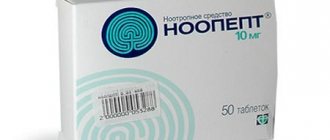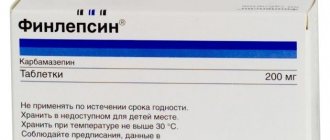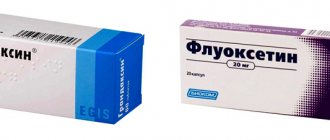Effect of the drug "Paxil"
As it becomes clear from the composition of the drug, Paxil is a strong selective inhibitor with an antidepressant effect. It is used in the treatment of mental disorders and at the same time differs in its chemical structure from other drugs of similar action.
For depression
- Paxil does not affect the functioning of the heart and does not affect blood pressure.
- Its processing occurs in the liver; after influencing the necessary parts of the body, the substances included in the drug are excreted from the body with urine and feces within 24 hours.
- Paxil accumulates in the blood and reaches the required concentration within 1-2 weeks. If you strictly adhere to the therapeutic dosage, then almost all of the paroxetine substance is associated with plasma. A slight increase in the concentration of the substance in plasma, not exceeding acceptable limits, can sometimes be observed among older people.
When does Paxil start to work? Paxil (Rexetine)
Pharmacological group: Antidepressants; SSRI Pharmacological action: Paxil is a potent and selective 5-hydroxytryptamine (5-HT, serotonin) reuptake inhibitor. It is generally accepted that its antidepressant activity and effectiveness in the treatment of obsessive-compulsive (OCD) and panic disorder is due to the specific inhibition of serotonin reuptake in brain neurons. Effect on receptors: Muscarinic cholinergic receptors (weak affinity); Alpha1-, alpha2- and beta-adrenergic receptors (weak affinity) Dopamine (D2), 5-HT1-like, 5HT2- and histamine (H1) receptors (weak affinity). Systematic (IUPAC) name: (3S, 4R) -3 - - 4 - (4-fluorophenyl) piperidine Trade names: Paxil, Pexeva, Brisdelle Legal status: available by prescription only Administration: oral Bioavailability: completely absorbed from the gastrointestinal tract, initially metabolized in the liver; the time to reach the maximum concentration of the drug is from 4.9 hours (with food) to 6.4 hours (on an empty stomach). Plasma protein binding: 93-95% Metabolism: extensive, hepatic (mainly mediated by CYP2D6) Half-life: 24 hours (range 3-65 hours) Excretion: 64% in urine, 36% in bile Formula: C19H20FNO3 Mol. weight: 329.3
Paxil (also known by the trade names Aropax, Paxil, Pexeva, Seroxat, Sereupin and Brisdelle) is an SSRI (selective serotonin reuptake inhibitor) antidepressant. Paxil is used to treat major depressive episodes, obsessive-compulsive disorder, panic disorder, social anxiety, post-traumatic stress disorder, generalized anxiety disorder, and vasomotor symptoms (eg, hot flashes and night sweats) associated in adult outpatients with menopause. In 1992, the drug was introduced to the market by the pharmaceutical company SmithKline Beecham (now GlaxoSmithKline). Since 2003, when the patent expired, generic versions of the drug began to appear. In adults, Paxil's effectiveness for treating depression is comparable to previous generations of tricyclic antidepressants, with fewer side effects and less toxicity. The differences with the newer antidepressants are more subtle and mostly limited to side effects. The drug has common side effects and contraindications with other SSRIs, including nausea, drowsiness and sexual side effects. Paxil causes clinically significant weight gain. Trials of Paxil in childhood depression failed to demonstrate that it was statistically more effective than placebo. Stopping Paxil is associated with a high risk of developing withdrawal syndrome. Due to the increased risk of birth defects, pregnant women and women planning pregnancy are advised to consult their doctor before using the drug.
Dosage for taking Paxil
- Taken orally. Taken in the morning, the tablet should not be chewed and washed down with a small amount of boiled water.
- The usual dose is 20 mg. If there is no effect, it can be increased to 30 mg as prescribed by a doctor. It is necessary to adjust the dose after two to three weeks of treatment with the drug. Taking more than 50 mg per day is not recommended
- It was noted that when taking Paxil, the composition of food and alcohol have a minimal effect on the effect of the drug, which is still not recommended to be consumed during the course of treatment.
Large packaging
Do not suddenly stop taking the drug - a gradual dose reduction is recommended.
Release form and composition
Paxil is available in the form of film-coated tablets: white, oval, biconvex, engraved with “20” on one side and with a break line on the other (10 pieces in a blister of PVC/aluminum foil or PVC/PVDC/ aluminum foil; in a cardboard pack 1, 3 or 10 blisters).
Composition of 1 tablet:
- Active substance: paroxetine hydrochloride hemihydrate – 22.8 mg (corresponding to 20 mg of paroxetine base);
- Additional components: magnesium stearate, sodium carboxymethyl starch type A, calcium hydrogen phosphate dihydrate;
- Shell composition: polysorbate 80, macrogol 400, titanium dioxide, hypromellose.
Overdose of the drug "Paxil"
If the medication exceeds the average dosage, vomiting and convulsions are possible, nausea, asthenia, increased excitability, and dizziness are possible. Urinary retention and an unmotivated aggressive state may occur.
Also among the negative effects of an overdose are dizziness, changes in heart rhythms are possible, consciousness may become confused, and in severe cases a coma may occur. In case of overdose, immediate gastric lavage is indicated, after which adsorbents must be introduced into the body.
Price
The cost of an antidepressant depends on the number of tablets in the package.
One box contains 1, 3, 10 blisters. You can buy the medicine at a pharmacy or online store.
The price in Moscow for the drug is:
- pack of 30 tablets – 714-740 rubles;
- pack of 100 tablets – 1961-2164 rubles.
An antidepressant belongs to a group of drugs available without prescription.
In Russia, a number of psychotropic drugs have been allocated for free sale, which includes Paxil. But in any case, taking available medications without a doctor’s prescription is strictly prohibited.
Analogues of "Paxil"
Analogues of the drug "Paxil", which contain one or more substances that have the same effect, are a large group of antidepressants.
Among them:
- "Adepress"
- "Actaparoxetine"
- "Apo-Paroxetine"
- "Paroxetine"
- "Plizil"
- "Plizil N"
- "Rexetine"
- "Sirestill"
Analogue
It is not recommended to replace one medicine with another without a doctor’s prescription.
How Paxil works
The drug functions primarily as a potent selective serotonin reuptake inhibitor (SSRI). Paxil affects neurotransmitters, chemicals that nerve cells use to communicate with each other. Neurotransmitters are produced and released by nerves and then travel and attach to nearby nerves. Thus, neurotransmitters can be thought of as the brain's communication system.
Serotonin is one of the neurotransmitters that is released by nerves in the brain. Serotonin either moves through the space between nerves and attaches to receptors on the surface of adjacent nerves, or it attaches to receptors on the surface of the nerves that produced it, only to be taken up by the nerve and released again.
Reviews from doctors
In combination with Paxil, I prescribe tranquilizers to minimize the incidence of side effects. Based on the experience of my practice, I trust benzodiazepines more (Diazepam, Alprozalam, Bromazepam, etc.). This tandem relieves anxiety attacks and panic attacks.
With a well-designed regimen, withdrawal syndrome can be avoided. If a patient presents with a problem for the first time, I do not prescribe Paxil due to the high likelihood of side effects.
Paxil works well in complex therapy for depression, panic attacks and obsessive thoughts.
During my practice, there have been cases of side effects in patients caused by the active component of the antidepressant. To eliminate them, I adjust the treatment regimen, including changing the dosage.
Another feature of the drug is the ability of the drug to cause withdrawal symptoms after finishing taking the pills.
Is there a withdrawal syndrome?
Oh yeeees. And what kind. Paxil is famous for its withdrawal syndrome, which is described by many patients on forums, and almost everyone has encountered it. This is the only drug that “hooked” me. Even though I reduced it very gradually - by a quarter a week. However, my withdrawal syndrome was not very severe, since I did not take the drug for very long.
First of all, it is a feeling as if electric discharges are hitting the skull. It's not a very pleasant feeling, but it only lasts a few days.
Nausea, indigestion, and fever are also possible. Some people even begin to break down, like drug addicts.
If you experience Paxil withdrawal symptoms, wean off Paxil very slowly. Up to eighth every two weeks.
This is especially true for those who have been drinking it for more than a year.
Contraindications
You should only take Paxil after consulting your doctor if you have:
- An allergic reaction to the drug or its components.
- Heart problems.
- Eye diseases (glaucoma).
- Epilepsy.
- Diabetes.
- You are trying to get pregnant, pregnant or breastfeeding.
The medicine is also used for prophylaxis to prevent exacerbation of chronic diseases that have developed against the background of mental destabilization.
Paxil is prescribed as an independent drug and in combination with other pharmacological drugs.
When choosing a corrective drug, the attending physician takes into account the contraindications indicated by the manufacturer in the instructions.
Paxil has the following restrictions for use:
- Allergy to one or more substances included in the medicine.
- When taking the drug simultaneously with MAO inhibitors. Restrictions apply for 2 weeks after therapy.
- In combination with thioridazine (the active component of Paxil increases the concentration of thioridazine in the blood).
The antidepressant is not prescribed to patients carrying a child or while breastfeeding.
The rules for taking Paxil include swallowing the tablet whole with purified water (100-150 ml). There is no need to chew the pill.
You need to take the medicine in the morning with meals.
The dosage is determined by the attending physician, taking into account the complexity of the disease and the presence of complications:
- When diagnosing depression, the daily dose is 20 mg, which corresponds to 1 tablet. If necessary, to achieve a therapeutic effect, the dosage is increased by 10-25 mg every week (daily maximum 50 mg). A long course of treatment requires medical supervision in order to promptly adjust the dose every 2-3 weeks. Paxil is not prescribed to children suffering from depression due to the lack of data on the therapeutic effect.
- For the treatment of OCD - the daily dose is 40 mg. For the first week, it is recommended to take 20 mg daily. For the second and subsequent 2 weeks, the norm is increased by 10 mg (daily maximum no more than 60 mg). For children (over 7 years old), at the initial stage of therapy it is recommended to take 10 mg daily, followed by increasing the amount of the active substance to 40-50 mg.
- When treating panic attacks, the daily dose is 10 mg of an antidepressant with a weekly increase in the amount of the active substance to 40 mg (daily maximum - no more than 40 mg).
- When diagnosing social phobia, the patient is prescribed a daily dose of 20 mg. Depending on the stage of the disease, the norm may increase to 40-50 mg. A similar scheme is used in the treatment of anxiety neurosis and mental disorders after injury. Children (over 8 years old) should start taking tablets with half. The dose is determined by the groove present on one side of the pill (10 mg). To achieve positive dynamics, the amount of active substance is increased to 40-50 mg.
After Cipralex turned out to be too weak for me, and I simply didn’t have enough money for large doses, the doctor switched me to amitriptyline, which made me gain 10 kg in a month. I got scared and asked for something else. And then I was prescribed Paxil.
This drug is one of the most common SSRI antidepressants; it is prescribed quite often, since the effect begins literally within a week, and its cost is average - about 700 rubles per month in a standard dose. If you think this is a lot, then remember Cipralex for 2000.
Paxil analogues
I drank only one of them - domestic Adepress. I can’t say anything bad about it, except that it is a little weaker than the original drug. But this worked to my advantage, since the side effects were not so strong, and there was no particular discomfort at all, but the effect was still there.
Many years ago, when I first had panic attacks, I had experience with a psychotherapist. Then there was no talk about treatment with antidepressants, the doctor conducted several NLP sessions with me and that was the end of it. It’s hard to say what helped me more then: either sessions with a psychotherapist, or independent measures in the form of lifestyle changes, contrast showers and physical activity. I think that it was a complex treatment and everything helped, what was more, what was less - is it really that important?
Slight dizziness, fog in the head, periodic mild headaches Problems with sleep - waking up earlier, sleeping no more than 6-6.5 hours, feeling groggy in the morning Fatigue, decreased performance Increased irritability, sometimes touchiness, frequent lack of mood Two years after the onset of this “nailed” state , after several consultations with neurologists and unsuccessful attempts to get rid of this scourge with both medications and various physical exercises, I was examined at the regional hospital in the cardiology department about bradycardia and a feeling of interruptions in the work of the heart, where I had the opportunity to go to appointment with an experienced neurologist, candidate of medical sciences.
Paxil - instructions for use Active ingredient - Paroxetine - is a powerful and selective 5-hydroxytryptamine (5-HT, serotonin) reuptake inhibitor. It is generally accepted that its antidepressant activity and effectiveness in the treatment of obsessive-compulsive (OCD) and panic disorder is due to the specific inhibition of serotonin reuptake in brain neurons.
In its chemical structure, paroxetine differs from tricyclic, tetracyclic and other known antidepressants.
Indications for use: The main indication is depression of various origins. Paxil is used for reactive, atypical, postpsychotic depression, dysthymia. The drug is effective for obsessive-compulsive disorders (obsessive-compulsive disorder), panic attacks, social phobias, agoraphobia, anxiety disorders of various origins, and nightmares.
There is evidence that the drug is effective in anti-relapse therapy for anxiety-phobic conditions. Positive results of Paxil therapy are observed in patients whose treatment with standard antidepressants turned out to be unsatisfactory. Paxil is indicated for patients with stress disorder in the post-traumatic period. Paxil can be used long-term, as well as for prophylactic purposes.
Directions for use: Take a Paxil tablet in the morning, do not chew it. Take after meals (although food does not affect the absorption of Paxil), wash down with water. The daily dose is taken once. When treating depression, social phobia, post-traumatic disorders, I use the following regimen: 20 mg daily in the first few weeks.
In gerontology and in weakened patients, they start with half a tablet (10 mg). To do this, the tablet is broken into pieces, and the other half is placed in a blister cell until the next dose. If the dose is well tolerated and the therapeutic effect is insufficient, it can be increased by 10 mg per week. For such patients, the dose of Paxil can be increased to 40 mg.
A similar dosage regimen is also used in patients with renal failure and liver pathologies. The treatment is long-term, its duration is determined by the doctor. Obsessive-compulsive disorder is treated with Paxil according to a regimen that includes an initial dose of 20 mg, followed by an increase of 10 mg weekly (in the absence of the expected therapeutic effect). The maximum allowable increase is up to 60 mg per dose.
For panic attacks, Paxil is prescribed at a dose of 10 mg/day at the beginning of treatment. The minimum dose is used due to the risk of exacerbation of symptoms at the beginning of treatment. The dose may be increased (maximum 60 mg/day). The increase is carried out gradually, adding 10 mg to the main dose weekly. Anti-relapse therapy consists of a maintenance dose of 20 mg/day.
Take Paxil “according to the plan”. I don’t remember the exact dosages and timing, but the idea is that you start taking Paxil with minimal doses, gradually increasing the dosage, and after about a week you reach the desired dosage (adjusted if necessary by your doctor). This is followed by taking the drug for at least a month and then another week to gradually reduce the dosage and completely stop taking Paxil.
I followed the doctor's instructions from start to finish. I would like to immediately say about the possible side effects of Paxil, which manifested itself in all its glory to me personally. This side effect mainly affects men. About a week after I started taking Paxil, I noticed that the time it took me to bring sexual intercourse to its “logical conclusion” had increased somewhat.
After another week, this became clearly noticeable and began to irritate. Those. There was a delay in ejaculation, and it was very noticeable. They say that a certain percentage of men suffer from premature ejaculation and simply dream of prolonged sexual intercourse, but this is clearly not about me. Sorry for the details, but when in order to cum you have to lather like a gray gelding during a race, then after a while you begin to think, do you need this at all? Although... you can provide paid services to single ladies with a quality mark. Joke of humor










